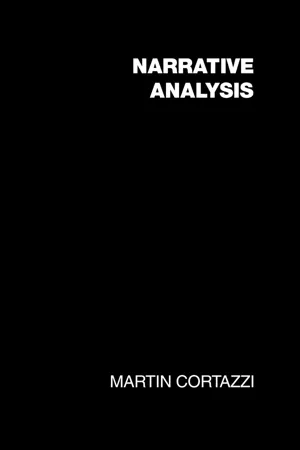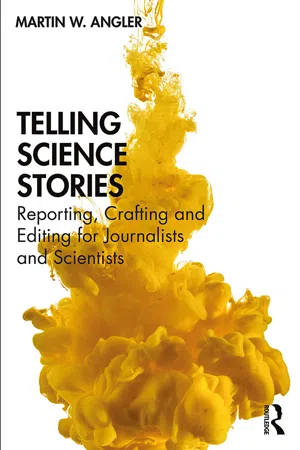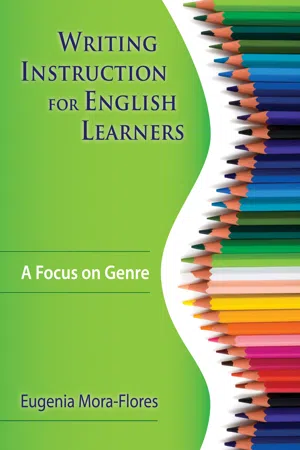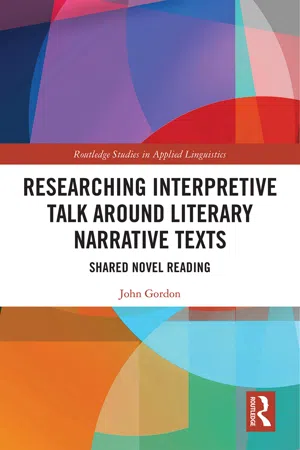Literature
Linear Narrative
A linear narrative is a storytelling technique where events unfold in a chronological order, following a clear beginning, middle, and end. This traditional approach to storytelling allows for a straightforward progression of events, making it easier for readers to follow the plot and character development.
Written by Perlego with AI-assistance
Related key terms
Related key terms
1 of 4
Related key terms
1 of 3
5 Key excerpts on "Linear Narrative"
- eBook - ePub
- Martin Cortazzi(Author)
- 2014(Publication Date)
- Routledge(Publisher)
There is an obvious major limitation in transferring insights from literary theory to an analysis of oral narratives of personal experience. Literary theory has primarily focussed on novels and short stories. It is expected that there will be far greater complexity, artistry and imagination in such written works, compared with the spontaneous, oral non-fictional narratives of personal experience. Yet many theorists of literature have paid detailed attention to oral stories in order to understand basic problems of narrative (Todorov, 1969 and 1977; Hendricks, 1973;Table 12 : A Minimal NarrativeBremond, 1973; Prince, 1973; Greimas, 1983) and some writers have held that the study of oral narrative reveals fundamental structures and processes of literary genres (Labov and Waletsky, 1967; Toolan, 1988; Maclean, 1988). Conversely, insights from literary theory may illuminate a study of oral narratives.Definitions of Narrative
In their attempts to define narrative a number of literary theorists have suggested three necessary conditions or criteria. These are temporality , causation and human interest. The three are seen as combining to form a minimum plot structure. Plot is ‘the dynamic, sequential element in narrative literature’, ‘the only indispensable skeleton’, the ‘most essential’ but ‘least variable’ element of narrative (Scholes and Kellogg, 1966, pp. 207 and 238-9).Temporality
Temporality is a first necessary condition for a narrative. The notion of plot involves a sequence of events in time. This chronological feature has been stressed since the Aristotelian formulation of plot requiring a beginning, a middle and an end. Other elements of tension, resolution, equilibrium and causation can be included, as in table 12 , based on Prince (1973, pp. 19-28), Todorov (1969, p. 74; 1977, p. 111), Chatman (1978, p. 37; 1988, p. 23) and Ricoeur (1984, pp. 52-87). Such a minimal narrative involves three conjoined events: the beginning state, a state of equilibrium which pre-figures a change where a character (or the audience listening) envisages what is likely to happen next and plans to intervene to offset the outcome; a middle action which sets up tension by a dynamic change or disequilibrium through character action as the events unfurl; and a final state, the resolution or outcome which is the inversion of the first. The first and second events, and the second and third are linked by conjunctive features of time - eBook - ePub
Telling Science Stories
Reporting, Crafting and Editing for Journalists and Scientists
- Martin W. Angler(Author)
- 2020(Publication Date)
- Routledge(Publisher)
Indeed, most representations of story structures manifest as two-dimensional line graphs of sorts, where one axis is time and the other one is tension or action (like Freytag’s and Hart’s). The planner then distributes plot points on that axis. That’s it. Plotting and outlining is all about selection and ordering. And rejection. Investigations practically never result in short pieces. In his book Story-based Inquiry (freely available, just Google it), investigative journalist Mark Lee Hunter details how to come up with an appropriate narrative at the end of an extensive investigative journalism project. You can structure your narrative in two ways. First, use a picaresque structure to order events by place, with the characters moving across those places over time. Homer’s Odyssey is an example of this structure. On a more contemporary note, Michael Moore tends to use that sort of structure in his documentaries (Hunter 2011). I can’t help but think of James Bond movies when I read about this structure. Hunter doesn’t really draw his structures as story shapes. If he did, he’d have probably a third axis: tension, time (the regulars) and place. Hunter’s second type of narrative sounds familiar: it’s the chronological structure, which you should use when ordering your events by time. Ultimately, it’s the material you gathered during the reporting that will determine which structure is the best for your story, but “one of these forms is right for your story” (Hunter 2011:66). Here is a short recipe on how to structure narratives. Begin with a moment that hooks the audience. Start in the present, go back in time to show how we got there (past), then bring it all the way back to the present moment (this will allow the readers to absorb the story), and then say where the story is headed to next (the future). As for chronological stories, Hunter advises to not continuously hop back and forward in time, as this confuses the readers - eBook - ePub
Writing Instruction for English Learners
A Focus on Genre
- Eugenia R. Mora-Flores(Author)
- 2008(Publication Date)
- Corwin(Publisher)
Narrative writing tells a story by sharing the details of an experience. Narratives are the stories children love to hear, read, and enjoy. Though many narratives are accounts or recounts of things we have done or stories we have heard, our experiences also give us ideas for original stories. The following list details the main aspects of narrative writing:• Can be fiction or nonfiction, based on personal experiences, inspired by personal experiences, or completely made up;• Includes literary elements of plot, setting, and characters that are well defined and developed;• Answers who, what, when, where, how, and why about something we have experienced or have created;• Uses colorful details to help the reader share in the experience with you;• Presents information logically (from beginning to end) while at the same time can be craftly written with flashbacks or cyclical plotlines;• Contains dialogue (when appropriate) to provide insight into the thoughts and actions of the characters;• Provides a point or theme to the story; and• Can be written from any point of view.A misconception about English learners (ELs) is that they cannot write until they have mastered at least a conversational level of the English language. However, as we noted in the opening chapter, all students have ideas for stories through their lived experiences. These experiences are not language specific; all students have gathered a vast amount of ideas from their lives to write about. What we need to do as teachers is to help them find the medium by which to share their stories in English. This includes allowing ELs opportunities to express themselves in creative ways (see Figure 1.5 - eBook - ePub
Researching Interpretive Talk Around Literary Narrative Texts
Shared Novel Reading
- John Gordon(Author)
- 2020(Publication Date)
- Routledge(Publisher)
(Mitchell, 1981, p. 3)whatever learning children enjoy from their experience of novels in schools is shaped both by stories in print and by unique classroom mediations of them formed in each exchange between text, teacher and students. The value of novels in education must be as much a matter of pedagogy as one of curriculum or canon.3.1 Key Terms
3.1.1 Narrative
McQuillan’s glossary of narrative terms (2000, p. 23) acknowledges the difficulties of defining our foundational term narrative, and in doing so partly explains the subsequent persistence, divergence and complexity of narrative studies as the field attempting to define and explain it. He regards the definition of narrative as ‘unstable’ and elastic, offering eight associated meanings elaborated through wide-ranging citation of key theorists. Even the first meaning provided combines product and process as ‘a recounting’ of real or fictional events, with added complication that recounting assumes telling of a past event. McQuillan notes that this problematizes the status of dramatic narrative, given that it reveals actions in the present moment. Citing Prince (1982), Rimmon-Kenan (1983), Todorov (1966) and Greimas (1987), McQuillan highlights their assertions that narratives should comprise two or more events, the last two of these narratologists also arguing they must also be a ‘coherent whole with a continuant subject’ if they are to be more than random lists. A second and related meaning of narrative, drawn from structuralism, defines it as articulation of two linked elements: the temporal sequence of events (story) and the mode by which the story is represented (discourse). A third definition allows for narrative as ‘the production of surface units of meaning from a set of deep functions’, along the lines adumbrated by Vladimir Propp (Propp, Propp & Wagner, 1968, see below). Further definitions emphasise contextual dimensions of narrative, from Barthes’s emphasis on its production according to ‘the desire’ of its interlocutors (1977) to Smith’s assertion (1980) that each narrative is unique and ‘irreducible to any other narrative’. McQuillan’s interpretation of Derrida’s position (1980) is that narrative is essentially paradoxical, a concept resistant to consistent taxonomising but nevertheless necessary to aid our conceptualisation of a mutually recognised phenomenon. This relationship with human experience is apparent in definitions of narrative related to knowing and being. For Lyotard (1984, 1992) the word ‘narrative’ is etymologically linked to ‘gnarus’ in Latin, meaning to know, while the concept constitutes an expression of knowledge binding communities and legitimising shared values and beliefs. This account is worth noting relative to the rationale for reading literary novels together in class in formal education, where bringing a group of students together around a shared text is an immediate manifestation of communal reading activity. For Ricoeur and Derrida, ‘narrative is the necessary form of expression of human temporality’, essential to our conception of time and the relationships between past, present and future. An understanding of narrative comprising each of these meanings then entails recognition that narratives are significant as expressions of being (they are ontologic) and as expressions of knowledge (they are epistemic): they are far from trivial. - eBook - ePub
- Liz Moor(Author)
- 2021(Publication Date)
- Polity(Publisher)
value, and over time forms of economic writing became functionally specialized, so that they either claim to mediate value in different ways, or model different value systems altogether. This historical account is particularly useful in understanding why some economists (as well as economic sociologists and others) have recently displayed a ‘turn to narrative’ to understand different aspects of economic life. The chapter concludes with a brief discussion of claims that narrative is in decline or in peril. Here I explore arguments that narrative is in tension with information, as a way of knowing the world, and consider how far economic narratives might be challenged by the rise of data-based ways of knowing described in the preceding chapter.Narratives, stories and why they matter
Narratives and stories are fundamental to human life. Their most important function is to ‘shape time according to human priorities’ (Abbott 2008: 4; see also Bruner 2004 [1987]). In contrast to ‘clock time’, narrative deals in ‘events and incidents’ (Abbott 2008: 13) and this capacity to represent an event according to one’s own understanding of its significance is what defines it. The ‘art of storytelling’, for Aristotle, involves ‘the dramatic imitating and plotting of human action’ and through this process ‘haphazard happenings’ are made memorable over time (Kearney 2002: 3). Narrative is often distinguished from simple ‘history’, however, since historical writing has little freedom to invent without evidence, and is constrained by the existence of sources that it should not contradict without good reason (Fludernik 2009: 3). Yet historical writing shares with narrative the sense of having a perspective – it comes from a particular person, place and time – and thus as being a mediation, something that ‘comes between us and the world’ (Abbott 2008: 154), directing our attention to some parts and not others.Narratives and stories also have an ideological function. For Lévi-Strauss, they were ways of providing ‘symbolic solutions to contradictions which could not be solved empirically’ (Kearney 2002: 6). This, as we shall see, is a useful perspective on the way that economic questions are represented in fiction, and is a key assumption of ideology critique. In this view, happy endings in stories about poverty, or ‘just desserts’ for greedy characters in films, defuse in the symbolic world something that may be less easily resolved in the real world. The more optimistic account of narrative is that it also has the ability to change our minds and to shift us away from comfortable or comforting beliefs. The ‘creative redescription of the world’ that defines narrative’s mimetic function may be a way of domesticating the world and making the complex comprehensible, or the unbearable palatable, but at its best it also allows ‘hidden patterns and hitherto unexplored meanings’ to unfold (Kearney 2002: 12–13). It may enable us to empathize with characters who suffer, while giving sufficient aesthetic distance to allow us to discern the ‘hidden causes of things’ and the greater philosophical truths underpinning the action.
Index pages curate the most relevant extracts from our library of academic textbooks. They’ve been created using an in-house natural language model (NLM), each adding context and meaning to key research topics.
Explore more topic indexes
Explore more topic indexes
1 of 6
Explore more topic indexes
1 of 4




